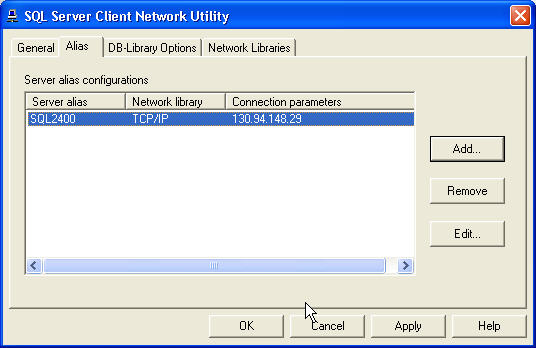
The tests need to be done on client machine for sure. Note that firewall should never be an issue for local connections.Īt this stage, you can test your connection using some tools. IPSec between machines that we are not trusted could also block some packets. Meanwhile, you can put sqlservr.exe and sqlbrowser.exe into exception as well, but this is not recommended. Both file sharing and NP use SMB protocol underneath.įor TCP protocol, you need put the TCP port on which the SQL Server listens on into exception.įor SQL Browser, please put UDP port 1434 into exception. Long term solution is to put exception for SQL Server and SQL Browser.įor NP protocol, please make sure file sharing is in firewall exception list. An easy way to isolate if this is a firewall issue is to turn off firewall for a short time if you can. If you are not able to access the remote SQL Server, please ask your admin to make sure all these happen.Ī firewall on the SQL Server machine (or anywhere between client and server) could block SQL connection request. If the target SQL instance is a named instance, you also need to make sure SQL Browser is running on the target machine. %ProgramFile%Microsoft SQL Server/MSSQLxx.xxx/MSSQL/Log The location of errorlog file is usually under: You can open errorlog file to see if the server is successfully listening on any of the protocol. Once you enabled protocols in SCM, please make sure restart the SQL Server. For remote connection, NP and/or TCP protocols must be enabled. SQL Server supports Shared Memory, Named Pipes, and TCP protocols (and VIA which needs special hardware and is rarely used). You can use SQL Server Configuration Manager (SCM) to enable protocols on the server machine. You need to make sure the target SQL Server is running and is listening on appropriate protocols. "Cannot Generate SSPI Context" error message, Poisoned DNS Wrong DNS entry could cause of all sorts of connectivity issue later.

The correctness of DNS configuration on the network is vital to SQL connection.
SQL SERVER CLIENT TOOLS CONNECTIVITY WINDOWS
Windows firewall does not block ping (ECHO) packet by default. It's possible the target machine is behind a firewall and the firewall blocks the packets sent by ping, though. If you are not able to ping your target machine, it has high chance that either the network is broken or the target machine is not running. (type your local and remote machine name and IP address multiple times)īe careful to see any mismatch on the returned results. (use -4 and -6 for IPv4 and IPv6 specifically) The first thing to trouble shoot SQL connectivity issues is to make sure the network we rely on is workable and stable. For remote connection, a stable network is required. You might be able to make local connection without a working network, but that's a special case. Usually, customers see connectivity issue in their applications, but it would be great if you can follow the steps below to eliminate issues one by one and post a question on Here comes a proposal based on my experience.īasically, when you failed to connect to your SQL Server, the issue could be:
SQL SERVER CLIENT TOOLS CONNECTIVITY HOW TO
I guess it would be helpful if we can put some guidance on how to resolve connectivity issues.

Simply, you can use Pingcmdlet to verify that the Application Server can communicate and reach properly with the Database Server over the network.We have been seeing and trying to resolve SQL connectivity issue all the time. How to Check Connectivity between Application Server and Database Server So that, In the next section, we’ll explore multiple ways to make sure that the Application server can reach the database Server properly.

1 Check the connectivity between Application Server and SQL Server Instance in Database Server.


 0 kommentar(er)
0 kommentar(er)
